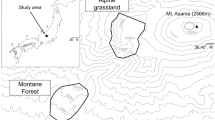Summary
Grazing in patches of Cynodon dactylon and of Sporobolus spicatus by four large herbivores, and the interaction between these sedentary herbivores was studied in Lake Manyara National Park, northern Tanzania. The herbivores were the African buffalo, Syncerus caffer; the African elephan, Loxodonta africana; the Burchell's zebra, Equus burchelli; and the wildebeest, Connochaetus taurinus. Four different hypotheses of the interactions between the herbivores were tested, viz., increased predator detection/protection through association of species, facilitation of the food intake through the influence of other species, use by other species of the food manipulation strategy of buffalo, and interspecific competition for food. On the level of a single day, zebra and wildebeest were symbiotic, which could have been caused by an increased chance of predator detection. A similar association between buffalo and wildebeest or zebra was also detected on C. dactylon grasslands. There was no indication of facilitation between any of the herbivores. Buffalo had a despotic relationship with elephant, that is the elephant's consumption was lowered when buffalo had visited a patch prior to their arrival. When elephant and buffalo arrived at the same time there appeared to be scramble competition between them.
Habitat overlap was calculated for four pairs of species. In conjunction with the analyses of the patch visits, it was concluded that a small overlap was associated with interspecific competition and a large habitat overlap was associated with symbiosis.
Similar content being viewed by others
References
Beekman JH, Prins HHT (1989) Feeding strategies of sedentary large herbivores in East Africa, with emphasis on the African buffalo. Afr J Ecol pp 129–147
Bell RHV (1970) The use of the herb layer by grazing ungulates in the Serengeti. In: Watson A (ed) Animal populations in relation to their food resource. Blackwell Scientific Publications, Oxford, pp 111–123
Coe MJ, Cumming DH, Phillipson J (1976) Biomass and production of large african herbivores in relation to rainfall and primary production. Oecologia 22: 341–354
Delany MJ, Happold DCD (1979) Ecology of African mammals. Longman Group Ltd, London
Drent RH, Prins HHT (1987) The herbivore as prisoner of its food supply. In: van Andel J, Bakker JP, Snaydon RW (eds) Disturbance in grasslands-species and population responses. Dr W Junk Publishing Cie, Dordrecht, pp 133–149
Field CR (1972) The food habits of wild ungulates in Uganda by analysis of stomach contents. E Afr Wildl J 10: 17–42
Greenway PJ, Vesey-FitzGerald DF (1968) The vegetation of Lake Manyara National Park. J Ecol 57: 127–149
Gwynne MD, Bell RHV (1968) Selection of vegetation components by grazing ungulates in the Serengeti National Park. Nature 220: 390–393
Hansen RM, Mugambi MM, Bauni SM (1985) Diets and trophic ranking of ungulates in the northern Serengeti. J Wildl Manage 49: 823–829
Hofmann RR (1973) The ruminant stomach-stomach structure and feeding habits of East African ruminants. East African Literature Bureau, Nairobi/Kampala/Dar es Salaam
Jarman PJ (1971) Diets of large mammals in the woodlands around Lake Kariba, Rhodesia. Oecologia 8: 157–178
Jarman PJ, Sinclair ARE (1979) Feeding strategy and the pattern of resource partitioning in ungulates. In: Sinclair ARE, Norton-Griffiths M (eds) Serengeti, dynamics of an ecosystem, University of Chicago Press, Chicago, pp 130–163
Leuthold W (1978) Ecological seperation among browsing ungulates in Tsavo East National Park, Kenya. Oecologia 35: 241–252
Loth PE, Prins HHT (1986) Spatial patterns of the landscape and vegetation of Lake Manyara National Park. ITC J 1986(2): 115–130
Maddock L (1979) The “migration” and grazing succession. In: Sinclair ARE, Norton-Griffiths M (eds) Serengeti, dynamics of an ecosystem. University of Chicago Press, Chicago, pp 104–129
McNaughton SJ (1976) Serengeti migratory wildebeest: facilitation of energy flow by grazing. Science 191: 92–94
Mills MGL, Wolff P, LeRiche EAN, Meyer IJ (1978) Some population characteristics of the lion Panthera leo in the Kalahari Gemsbok National Park. Koedoe 21: 163–171
Pianka ER (1973) The structure of lizard communities. Ann Rev Ecol Syst 4: 53–74
Prins HHT (1988) Plant phenology patterns in Lake Manyara National Park, northern Tanzania. J Biogeogr 15: 465–480
Prins HHT, Beekman JH (1989) A balanced diet as a goal of grazing-the food of the Manyara buffalo. Afr J Ecol pp 241–259
Prins HHT, Iason GR (1989) Dangerous lions and nonchalant buffalo. Behaviour pp 262–296
Prins HHT, Loth PE (1988) Rainfall patterns as background to plant phenology in northern Tanzania. J Biogeogr 15: 451–563
Schoener TW (1983) Field experiments on interspecific competition. Am Nat 122: 240–285
Sinclair ARE (1985) Does interspecific competition or predation shape the african ungulate community. J Anim Ecol 54: 899–918
Sinclair ARE, Norton-Griffiths M (1982) Does competition or facilitation regulate migrant ungulate populations in the Serengeti? A test of hypotheses. Oecologia 53: 364–369
SPSSx (1986) SPSS Inc., Chicago
Stelfox JG, Peden DG, Epp H, Hudson RJ, Mbugua SW, Agatsiva JL, Amuyunzu CL (1985) Herbivore dynamics in southern Narok, Kenya. J Wildl Man 50: 339–347
Steward DRM, Steward J (1970) Food preference data by faecal analysis for African plain ungulates. Zoologica Africana 15: 115–129
Vandermeer JH (1972) Niche theory. Ann Rev Ecol Syst 3: 107–132
Van Soest PJ (1982) Nutritional ecology of the ruminant. O & B Books, Corvallis (Ore)
Van Wijngaarden W (1985) Elephants-trees-grass-grazers; relationships between climate, soils, vegetation and large herbivores in a semi-arid savanna ecosystem (Tsavo, Kenya). ITC Publication 4, Endschede/Ph D Thesis, University of Wageningen
Author information
Authors and Affiliations
Rights and permissions
About this article
Cite this article
de Boer, W.F., Prins, H.H.T. Large herbivores that strive mightily but eat and drink as friends. Oecologia 82, 264–274 (1990). https://doi.org/10.1007/BF00323544
Received:
Accepted:
Issue Date:
DOI: https://doi.org/10.1007/BF00323544




